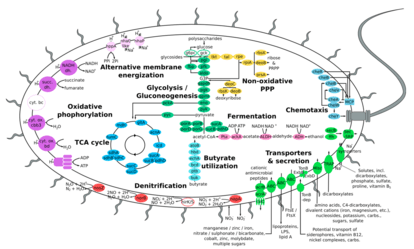Delphibacteria
Delphibacteria is a candidate bacterial phylum in the FCB group. The phylum was first proposed after analysis of two genomes from the mouths of two bottlenose dolphins. "Dephibacteria" was proposed in recognition of the first genomic representatives having been recovered from the dolphin mouth. Members of the Delphibacteria phylum have been retroactively detected in a variety of environments.

Description
Delphibacteria is a bacterial phylum with candidate status, meaning it has no cultured representatives as of yet. It is part of the FCB group.[2]
History
The phylum was first proposed following the recovery and analysis of two genomes, each from the mouth of a different bottlenose dolphin.[1] These dolphins were part of the US Navy's Marine Mammal Program, although Delphibacteria 16S rRNA genes have also been detected in the mouths of wild dolphins living off the coast of Florida, U.S.[1][3] The first characterized member of the Delphibacteria phylum was inferred to be a heterotrophic organism with the genomic potential for oxygen and most likely nitrate reduction.[1] It was hypothesized that the ability to perform denitrification may have an impact on dolphin physiology and health,[1] given that in humans denitrification by oral bacteria can affect oral and gastric blood flow, signalling in bacteria-bacteria and bacteria-host interactions, and mucus thickness in the stomach.[4][5]
The name "Dephibacteria" was proposed in recognition of the first genomic representatives having been recovered from the dolphin mouth (Family Delphinidae) and due to its ubiquity in dolphin mouths.[1][3] Members of the Delphibacteria phylum have been detected (retroactively) in a variety of environments, including bottom water from the Northern Bering Sea (EU734960.1), marine sediment from the Logatchec hydrothermal vent (FN554086.1), and deep sea sediment from the Okinawa Trough (KX097792.1).[1]
References
- Dudek, Natasha K.; Sun, Christine L.; Burstein, David; Kantor, Rose S.; Aliaga Goltsman, Daniela S.; Bik, Elisabeth M.; Thomas, Brian C.; Banfield, Jillian F.; Relman, David A. (2017-12-18). "Novel Microbial Diversity and Functional Potential in the Marine Mammal Oral Microbiome". Current Biology: CB. 27 (24): 3752–3762.e6. doi:10.1016/j.cub.2017.10.040. ISSN 1879-0445. PMID 29153320.
- Dudek, Natasha K.; Sun, Christine L.; Burstein, David; Kantor, Rose S.; Aliaga Goltsman, Daniela S.; Bik, Elisabeth M.; Thomas, Brian C.; Banfield, Jillian F.; Relman, David A. (2017-12-18). "Novel Microbial Diversity and Functional Potential in the Marine Mammal Oral Microbiome". Current Biology: CB. 27 (24): 3752–3762.e6. doi:10.1016/j.cub.2017.10.040. ISSN 1879-0445. PMID 29153320.
- Bik, Elisabeth M.; Costello, Elizabeth K.; Switzer, Alexandra D.; Callahan, Benjamin J.; Holmes, Susan P.; Wells, Randall S.; Carlin, Kevin P.; Jensen, Eric D.; Venn-Watson, Stephanie; Relman, David A. (2016-02-03). "Marine mammals harbor unique microbiotas shaped by and yet distinct from the sea". Nature Communications. 7 (1): 10516. Bibcode:2016NatCo...710516B. doi:10.1038/ncomms10516. ISSN 2041-1723. PMC 4742810. PMID 26839246.
- Schreiber, Frank; Stief, Peter; Gieseke, Armin; Heisterkamp, Ines M.; Verstraete, Willy; de Beer, Dirk; Stoodley, Paul (2010-03-22). "Denitrification in human dental plaque". BMC Biology. 8: 24. doi:10.1186/1741-7007-8-24. ISSN 1741-7007. PMC 2859859. PMID 20307293.
- Lundberg, Jon O.; Weitzberg, Eddie; Gladwin, Mark T. (February 2008). "The nitrate–nitrite–nitric oxide pathway in physiology and therapeutics". Nature Reviews Drug Discovery. 7 (2): 156–167. doi:10.1038/nrd2466. ISSN 1474-1784. PMID 18167491.